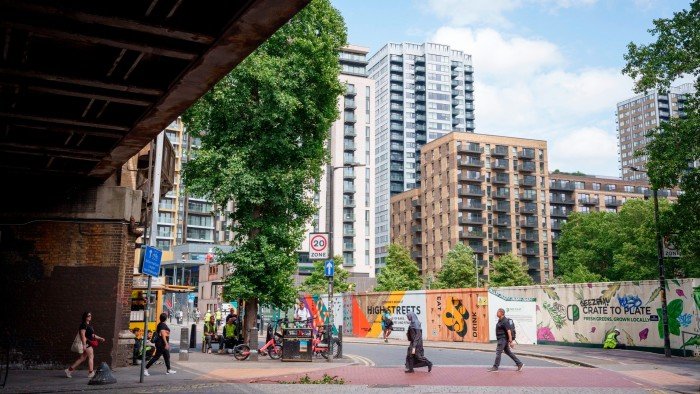The UK Labour government’s pledge to build 1.5mn homes in England by 2029 is under serious threat unless “drastic” reforms are made to the country’s approval process, industry leaders have warned.
Official building control data shows just 28,180 homes were started in the first quarter of the year, which is less than 10 per cent of the annual 300,000 target.
Real estate firm Savills forecasts that only 840,000 homes will be completed by 2028/29, falling 42 per cent short of the goal.
“Failing to tackle these delays will significantly hinder the government’s housebuilding targets and the infrastructure needed to support them,” warns Gary Strong, global building standards director at the Royal Institution of Chartered Surveyors (Rics).
Risk management: Property
The article is part of a special report on risk management in the property sector. Other pieces cover fire risks, cyber threats, and the secondary office market.
A major bottleneck is the new building safety regime, introduced in response to the 2017 Grenfell Tower fire in London, which claimed 72 lives. The tragedy exposed failures in the regulation of high-rise residential buildings, leading to a new safety framework and the creation of the Building Safety Regulator in 2022.
Under this regime, the BSR requires high-rise developments to pass a three-stage “gateway” approval process covering planning, construction, and completion.
High-rise buildings are crucial for meeting housing targets, especially in urban areas, because they provide high-density housing.
Significantly, applications submitted at Gateway 2 must be fully completed construction proposals, with no opportunity to submit plans on a stage-by-stage basis.
While the building and property industry broadly supports the framework, delays at the critical Gateway 2 stage have hit delivery of new projects.
36
Average wait in weeks for high-rise building approvals — three times the government’s target
Between January and March 2025, only 257 decisions were made at Gateway 2, out of a backlog of 1,276 applications according to the most recent data from the BSR. Approval times for high-rise buildings now average 36 weeks — three times the government’s target.
The delays are worse in the nation’s capital, according to Savills, where less than half of the 2,148 homes started in London in the first half of this year were on blocks over 18m, versus 71 per cent for the same period in 2019 before the new regulations were introduced.
Developers have criticised the BSR for ambiguous and inconsistent submission requirements, a lack of pre-submission support and heavy reliance on outsourced teams to assess applications due to a lack of in-house technical staff.
“The regulatory framework is not conducive to delivery,” said Mark Reynolds, executive chair of Mace Group, a global consulting and construction group, at a parliamentary inquiry in July.
Reynolds cited the requirement for fully designed plans at Gateway 2 as a particular challenge for the sector.
“The level of detail that was being asked, particularly at Gateway 2, was, quite frankly, beyond the capability of the system the industry works in,” said Reynolds.
“The industry is saying that this is a crisis today. We need to make the system work.”
Faced with mounting industry frustration with the backlog, the government in June announced a range of reforms to ease backlogs at the BSR including leadership changes, extra investment, more staffing, and a fast-track process to “enhance the review of new build applications”.
The Ministry of Housing, Communities and Local Government runs the BSR. In a comment to the FT, it said the regulator played a “crucial role in making buildings safer but to help us deliver 1.5mn homes we’re taking decisive action to create a stronger system that works for the sector, and keeps residents safe”.
“That’s why we have announced a package of reforms to the Regulator to reduce delays and build the homes this country desperately needs — delivering on our Plan for Change.”
But developers say that the changes need to go further.
“Everyone supports safer buildings, but a drastic overhaul of the system is required,” says Rebecca Taylor, managing director of multi-family business at Long Harbour, a real estate investment manager and building developer.
“A more staged approval process is needed to allow spades to get into the ground earlier. Delays at Gateway 2 impact planning approvals, and that’s hitting investor confidence.”
Martin Samworth, Rics board chair, is also calling for a more phased approach: “You used to get planning consent, then deal with details as you progressed. Now, Gateway 1 and Gateway 2 require a higher level of specification and cost — before external funding [from investors] is even in place.”
Reynolds, of the Mace Group, is calling for applications to be considered on an organisational basis, rather than individual.
“At the moment, there is a limited number of applications going through the process but, next year, there will be multiple applications from single organisations going through,” Reynolds told the Industry and Regulators Committee.
“So, where one organisation is putting in five or six applications now, it will be wanting to put in 40 at the back end of this year and next year,” he said, pointing to a potential surge in applications if the government’s target is to be met. “This goes back to whether we are going to build homes at capacity. Unless we have an ‘account management by organisation’ approach, we will not be able to deliver the capacity.”
Developers and investors say restoring confidence is essential.
“The government and the regulator need to provide clarity and certainty — both on application requirements and processing times,” says one senior executive at one major housebuilder. “Right now, projects are being paused. Investors are holding off.”

